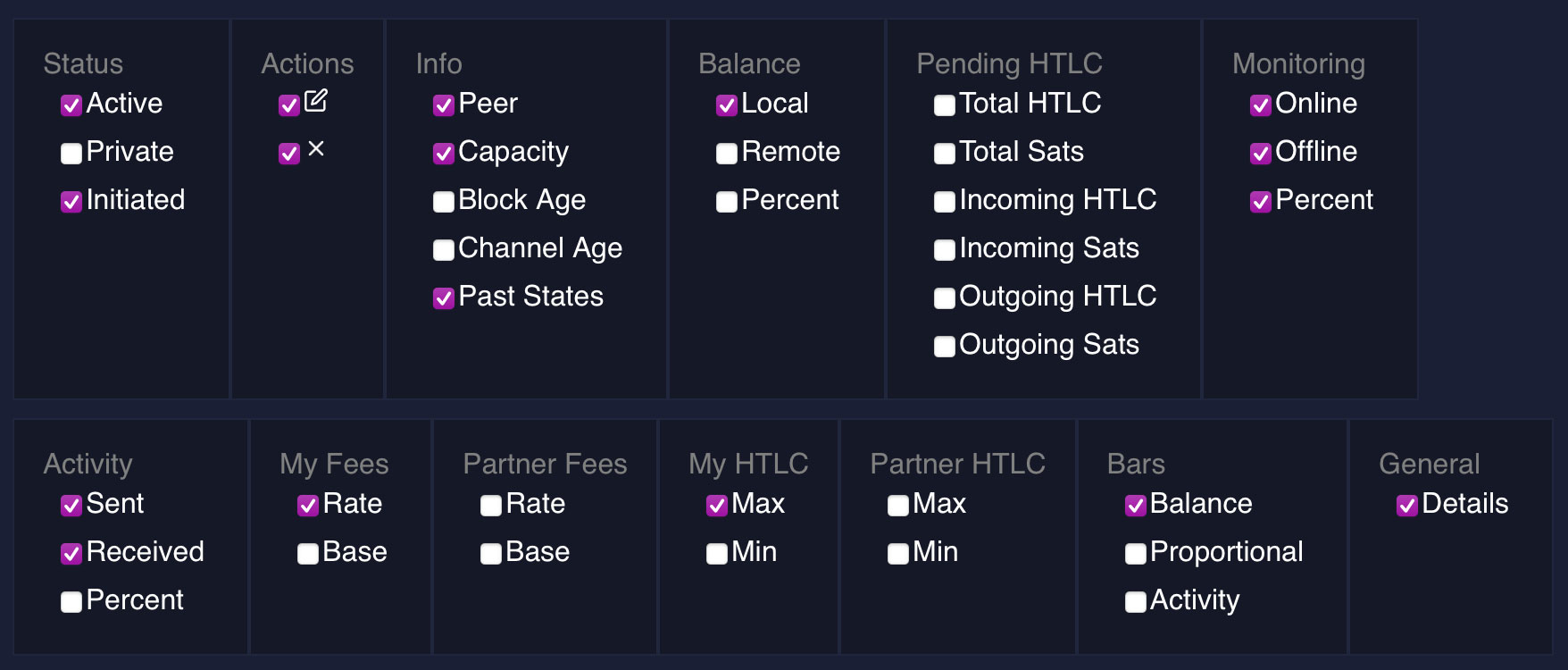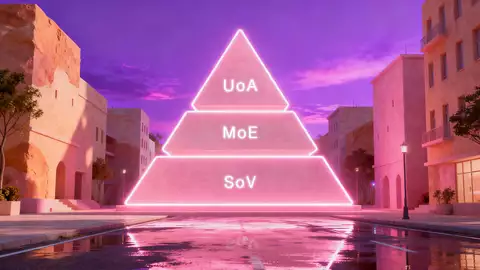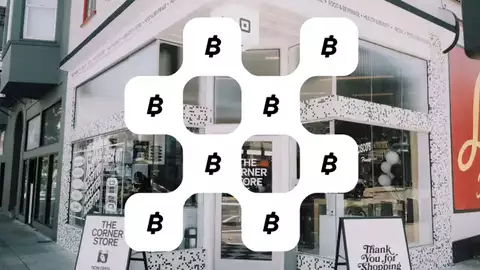
Unlocking the Mysteries of Lightning Channel Settings
Posted about 2 years ago by LN+
When operating a Bitcoin Lightning Network node, you have the option to use either a command line interface or a user-friendly visual tool like Thunderhub. Regardless of your choice, it's essential to understand the various settings and flags associated with each lightning channel. In this guide, we'll delve into the columns found in the 'Channels' tab of Thunderhub, which are also prevalent in other similar tools, explaining their significance for node operators.
Before diving deep, it's crucial to grasp some foundational aspects of the Lightning Network. In the Lightning Network, payments between two parties take place off-chain, meaning they aren't immediately reflected on the Bitcoin blockchain until the channel concludes, either through closure or settlement. This off-chain approach allows for rapid, low-cost transactions by eliminating the need to record every transaction on the blockchain. However, for this system to work securely, the Lightning Network employs HTLCs (Hashed Time-Locked Contracts). HTLCs act as a safety mechanism, temporarily locking funds and offering a window during which these funds can be claimed or returned, depending on whether conditions are met. This locking mechanism leverages Bitcoin's scripting capabilities, especially the CheckLockTimeVerify (CLTV) function. Additionally, as payments traverse through various channels to reach their destination (routing), node operators can impose fees, making channel and fee management a vital component for effective Lightning Network operations.

Status
- Active: Indicates whether the channel is active or inactive. An active channel means it can process transactions. If it's inactive for a long time, you should consider force closing the channel to ensure the funds are not lost if both ends of the channel happen to go offline.
- Private: If a channel is private, it's not announced to the entire Lightning Network. This means others cannot see it and make routing decisions based on its presence. Private channels do not participate in routing and thus, do not earn you routing fees. On the upside other nodes can't drain them either.
- Initiated: This denotes which party initiated the channel creation, whether it was you or your peer. This is important because the initiator pays the closing fees as well.
Actions
- Edit: Allows you to change certain aspects of the channel.
- Close: Enables you to close the channel, ending your connection and settling your balance on the main Bitcoin blockchain. When possible always close cooperatively. Only force close if the other node is offline for a long time, because force closing will lock the funds for a certain period of time.
Info
- Peer: Displays the node with which you've established this channel.
- Capacity: The total amount of Bitcoin that this channel can handle.
- Block Age: Shows how many blocks have been added to the Bitcoin blockchain since this channel was opened.
- Channel Age: Displays the actual time duration since the channel was opened. Older channels are more trusted by certain routing algorithms and they are also a source of pride for some lightning network operators proving the thesis that channels can stay open for a long time moving funds back and force hundreds of times.
- Past States: Indicates the number of times the channel's state has been updated. This includes successful and unsuccessful attempts to route. The larger the number the more space the channel takes on your disk. Some lightning network operators like to close channels that have accumulated a huge amount of past states (ex. 1,000,000+).
Balance
- Local: Amount of bitcoin on your side of the channel. This is how much you can spend from it.
- Remote: Amount of Bitcoin owned by your peer in this channel. This is how much you can receive on it.
- Percent: Represents the proportion of the channel's capacity that you own.
Pending HTLC
- Total HTLC: The number of Hashed Time-Locked Contracts currently pending. Every time you pay, receive, or route you create an HTLC contract.
- Total Sats: Total amount in Satoshis that's in pending HTLCs.
- Incoming HTLC: Number of incoming pending transactions.
- Incoming Sats: Amount in Satoshis of incoming pending transactions.
- Outgoing HTLC: Number of outgoing pending transactions.
- Outgoing Sats: Amount in Satoshis of outgoing pending transactions.
Monitoring
- Online: Shows how long your channel peer has been online.
- Offline: Shows how long your channel peer has been offline.
- Percent: Percentage of time the peer has been online. The higher the better.
Activity
- Sent: Amount you've sent through this channel.
- Received: Amount you've received through this channel.
- Percent: Represents the proportion of the channel's activity. Over time, this value closes in on 50%.
My Fees
- Rate: The rate at which you charge fees for transactions processed through your channel. Node operators often play around with this value to find the most optimal number where they can earn the most amount of fees.
- Base: A fixed amount of fees you charge for any transaction regardless of its size. Many node operators like to set this to zero, to encourage routing algorithms choose this channel for routing smaller amounts.
Partner Fees
- Rate: The rate at which your partner charges fees for transactions processed through your channel. You can't change this, it's up to your partner.
- Base: A fixed amount your partner charges for any transaction. Also up to your partner.
My HTLC
- Max: The maximum amount in Satoshis your partner is willing to lock in a single HTLC.
- Min: The minimum amount in Satoshis your partner is willing to lock in a single HTLC.
Partner HTLC
- Max: The maximum amount in Satoshis your partner is willing to lock in a single HTLC.
- Min: The minimum amount in Satoshis your partner is willing to lock in a single HTLC.
Bars
- Balance: A visual representation of the channel's balance between you and your peer.
- Proportional: Same as above but the scale is comparatively shown to other channels.
- Activity: A visual representation of the transaction activity on this channel. The higher the number the more active the channel and thus likely generates more earnings for you through routing.
General
- Details: Gives you a button to be able to adjust many of the settings above and also the value CLTV Delta.
CLTV Delta (CheckLockTimeVerify Delta) is a term used in the Lightning Network context. It represents the number of blocks between when a commitment transaction is confirmed and when the HTLC (Hashed Time-Locked Contract) output becomes spendable. The CLTV Delta is a safety margin. It ensures that if there's a need to close a channel and submit the transaction to the blockchain (for example, in the event of a dispute), there's sufficient time to do so before the HTLC expires. This is crucial for the Lightning Network's security. If the CLTV Delta is too small, there's a risk that a transaction might not be confirmed in time, which could result in loss of funds. Therefore, node operators on the Lightning Network often set a CLTV Delta of several blocks to ensure there's enough time for transactions to be processed in worst-case scenarios.
Understanding these settings and terms gives you a better grasp of how the Lightning Network operates and helps you manage your channels more effectively. Whether you're routing payments for others or using the network for your transactions, it's essential to be aware of what each setting signifies. Always remember to monitor and adjust your channels to ensure smooth transactions and maintain good relationships with your peers. Happy Lightning Networking!
0 Comments
Please login to post comments.

Lightning Network Node
LightningNetwork.Plus
Rank: 6 / Tungsten
Capacity: 55,000,000 SAT
Channels: 8
Latest news
Channel Rebalancing 101: Practical Strategies for Better Routing
Posted 2 days ago
Square Launches Lightning-Powered Bitcoin Payments: Zero Fees Until 2027
Posted about 1 month ago
Introducing Telegram notifications
Posted about 2 months ago
Introducing Nostr DM notifications
Posted 2 months ago




